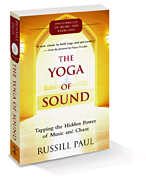3 Ways To Mantras And Creativity

First published in Common Ground May/June 2021 as "The Yoga of Sound: Mantras and Creativity"
When repeating a mantra is boring,
here's how to enliven your practice.
Today, there is widespread interest in kirtan and in mantra chanting, especially within the yoga community. It is as though Western yoga has discovered its soul through these expressions. And there is a lot of creativity happening with mantras, which while good in some ways, can compromise the power and potency of mantras on the other. Creativity, however, is important! It is in itself a form of healing. Mantras too are a form of healing. How then do we bring the two together—mantras and creativity?
Health, we are fast realizing, is not simply the absence of disease: it is a condition of soul that invigorates our being, enabling us to derive the most from life. Also, the effects of yoga as well as of sound vibrations upon our health and well-being have garnered credibility in recent decades. What if we can combine the two? That’s the idea behind the Yoga of Sound. There is tremendous scope and depth to a living tradition of sacred sound that has intimately intersected with the development of the Yoga tradition within Indian spirituality for thousands of years.
A common misconception in the West is associating kirtans with mantras. Kirtans are usually not mantras, nor are they mantras set to music. However, they don’t have to be mantras to have value—they are their own beautiful thing. Interestingly, mantras are usually not sung, but uttered, muttered, whispered, or recited mentally. Or, if chanted aloud, they use only a few musical tones.
The first thing that most people know about mantras is that they are a thing to be repeated. This is true of a certain type of mantra, but just so you know, not all mantras are repeated. For instance, Vedic mantras are generally not repeated. The type of mantra that is repeated typically derives from the Tantric tradition, and some of these mantras lend themselves to creativity, especially for the Western musician. There are added creative possibilities when such mantras also have a devotional aspect—that is, drawing from the tradition of bhakti (devotion). This is a broad yet useful categorization when approaching the study and practice of mantras—Vedic, Tantric, bhakti—which is also the approach in my book, The Yoga of Sound: Tapping the Hidden Power of Music and Chant.
There are several ways that devotional mantras can be expressed creatively.
The First Way: Using Just A Few Tones
First there is the method of using only a few tones. For instance, with the classic mantra “om namah shivaya,” you can use a base tone (not necessarily a bass tone) as your reference, which could be any tone or pitch you want it to be. Using it, you can vary the syllables of the mantra with one or two other tones. This is the easiest form of creativity with a mantra that pretty much anyone can enjoy playing with, for it helps the mantra to come alive. You can do this with or without rhythm, meaning you can let it flow any way you want without constraining it in a tempo. A lot of cantors in the Hebrew and Hindu traditions use this method, and you can be creative with it.
The Second Way: Using A Scale (A Raga)
Another, slightly more involved approach but requiring some musical knowledge is to use a musical scale as a reference to create a melody. In Indian music, ragas are usually used for this purpose, a raga being a set of intervals governed by specific rules. They can also relate to the time of day and the season of the year. Western musical scales are not as involved but just as good to create a mood of sadness or joy with the basic major or minor scale options. In this way, a mantra may be used to relieve us of painful energies and memories or to evoke joy and delight. Such expressions of creativity then become a means of healing.
The Third Way: Using A Rhythmic Pattern
There is, finally, the rhythmic aspect. Mantras in general are rhythmic because they are syllabic in meter, like poetry. There is, in other words, a natural rhythm built into the syllables. The inherent rhythm of a mantra can be further developed into more complicated rhythms by the creative musician. However, non-musicians can easily tap the rhythmic nature of mantras. For instance, with the classic mantra “sri rama jaya rama jaya jaya rama,”there is an inbuilt rhythm felt in the natural flow of the syllables. Just say it aloud, and you will feel it entrain (draw together in sync) your thought processes. This entrainment is one of the reasons that mantras are so powerful—they harmonize our thought patterns like pendulums moving in union when in proximity to one another. This was an actual discovery in the 1600s by Dutch physicist Christiaan Huygens that opened up the possibilities of entrainment to the scientific community. Ancient Hindus were acutely aware of this millennia ago. Mantras are a spiritual technology that possesses the power to entrain.
The syllabic aspect of mantras are very powerful in creating inner harmony. For instance, our various body rhythms such as our pulse and heartbeat and circulation can be affected in positive ways when syllabic patterns are created with auditory forms. This is now medically established: chant heals the body. But it also heals the mind, for embedded within mantras are the names of deities that are also divine attributes. For instance, Shiva means “auspicious.” So what we are doing is saying, “I’m favored by the universe” over and over again when we repeat the word Shiva, and this brings favorable conditions into our lives. However, if you associate Shiva with destruction, which is not what it literally means, then your emotion around the meaning could attract a different result.
We are seeing a great deal of creativity being unleashed with both mantras and kirtans in the West today. While the musician in me welcomes this, the mantra practitioner in me cautions that some effort must be channeled into pronunciation over time because it is an essential characteristic of mantras. Mantras are constructed on the principle of sound vibrations accurately creating an intended effect, much like how the physical architecture of the body affects yoga asana practice. And music, which is such a powerful medium in its own right, can mask the improper pronunciation of a key word in a mantra. To alter its sound form is therefore altering the meaning and the vibrations of the mantra. Mantras, traditionally, have not been used in creative compositions by Indian musicians for many thousands of years in order to preserve their sound form, phonetics, and meter, which can be compromised when made to fit melody flow and time signature.
So while it is important that our creative freedoms are not too curtailed, it is just as important that we are well-informed about mantras. I am excited that we have begun to tap the tip of the great iceberg that is the Yoga of Sound.
Russill Paul is the author of The Yoga of Sound: Tapping the Hidden Power of Music and Chant and several best-selling yoga chant CDs. He also teaches online through his Yogic Mystery School and offers a chanting pilgrimage in India each year.




